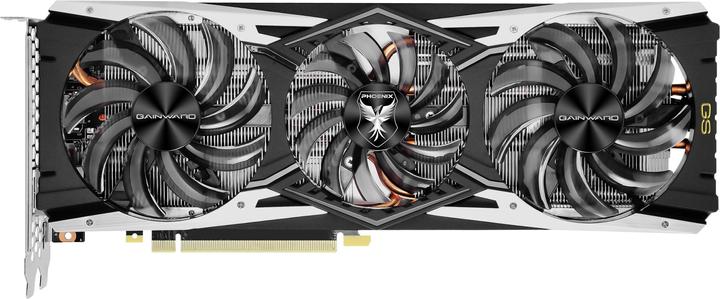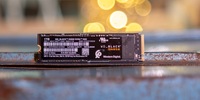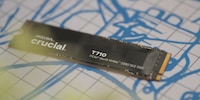

WD Black SN750 tested: How does the M.2 SSD with heatsink perform?
Western Digital is launching the M.2 SSD SN750 in two versions: One with a heatsink and one without. Is such a heatsink any good and how does the M.2 SSD perform in practice?
I'm a fan of M.2 SSDs. They're fast, take up little space and don't need ugly SATA cables. So far I've sworn by Samsung. With the Black SN750, WD has released an SSD that can compete with Samsung.
Of particular interest is the fact that WD is releasing the SN750 in two versions: one with and one without a heatsink. A heatsink is a passive heat sink designed to dissipate heat from sensitive electronic components. This has its price at Western Digital: it costs 70 francs/euros more for the 500 GB model and 80 francs/euros more for the 1 TB model than the version without a heatsink. A lot of money for something you might not even need.
To test the performance of the SN750, I grab one version with a heatsink and one without. For comparison, I put the two models up against my 970 Evo from Samsung.
The SN750 in detail and the test scenario
WD not only calls the SN750 Black, the M.2 SSD also comes in plain black. Inside, Western Digital uses 64-layer 3D NAND TLC memory chips with the designation BiCS3 X3. The SanDisk 20-82-007011 is used as the controller with 1 GB DDR4 memory as the DRAM cache.
Here are the other details according to WD:
Storage capacity: 500, 1000 or 2000 GB
Form factor: M.2 2280
SSD protocol: NVMe
Read rate: 3400 MB/s
Write rate: 2900 MB/s
Max. Random 4k Read: 480000 IOPS
Max. Random 4k Write: 550000 IOPS
I tested the SSDs with the following components:
The system is cooled by a custom water cooling system for the CPU.
I test with this software
I use CristalDisk Info to monitor the temperature of the SSDs. The tool also gives me information on the health of the drives, interface and transfer mode. As I realise on closer inspection, the programme shows me PCIe 2.0 x4 for the transfer mode of the SN750. However, the WD SSD has PCIe 3.0 x4. I have attached the SN750 to the M2_2 slot on my mainboard. As a quick search shows, my motherboard unfortunately only has PCIe 2.0 on the M2_2 slot.
PCIe 2.0 theoretically offers 5 GBit/s bandwidth, PCIe 3.0 10 GBit/s. On paper, the capacity for data transfer with PCIe 3.0 is therefore at most twice as large as with PCIe 2.0. My Samsung 970 EVO would have an unfair advantage in data transfer, as it is connected to the M2_1 slot, which has PCIe 3.0. I therefore connect the M.2 SSDs to the M2_1 slot of my mainboard so that all models have the same requirements.
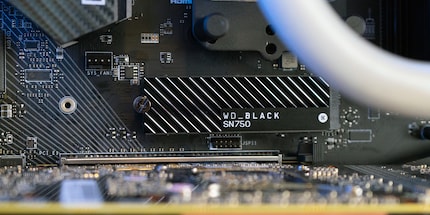
The ATTO Disk Benchmark uses raw data. It tests the read and write performance of various transfer sizes from 512 B to 64 MB. The read and write performance specifications of many manufacturers are based on this test methodology: it delivers better results as raw data can be read and written quickly. In everyday life, however, SSDs also have to deal with compressed data, which is why I run additional benchmarks.
The storage benchmark from PCMark 8 is a little more geared towards an actual scenario. The PC Mark 8 storage test simulates work steps of various applications from the Adobe Creative Suite, Microsoft Office and games. During this process, it records the storage activity and generates a benchmark score based on the saved hard drive activity. You can find more information here.
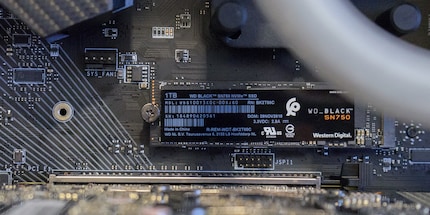
The benchmark from Anvil's Storage Utilities not only shows read and write speeds, but also information on IOPS and response times. I can also determine the proportion of compressible and non-compressible data in the benchmark. I set the proportion to 46 per cent compressible data. I leave the remaining settings at default.
In addition to the three benchmarks, I measure the loading time for "Final Fantasy XV", "Rise of the Tomb Raider" and "Resident Evil 2 Remake". Last but not least, I install Battlefield 5 and see how long the installation takes.
The benchmarks
First, I run the ATTO Disk Benchmark. This gives me an idea of whether the manufacturer's specifications are correct. The first thing I notice: The SN750 with and without heatsink deliver exactly the same results. I can't remember ever seeing that in a benchmark.
ATTO Disk Benchmark
The SN750 only develops its full read and write speed from 64 KB. The write rate is 2.8 GB/s and the read rate is 3.26 GB/s. The 2.9 GB/s and 3.4 GB/s promised by the manufacturer are therefore not achieved in the benchmark. The Samsung Evo 970 achieves a write rate of around 2.3 GB/s and a read rate of 2.9 GB/s. The Samsung is only faster for small data up to 2 KB. In terms of size, the differences in speed are negligible.
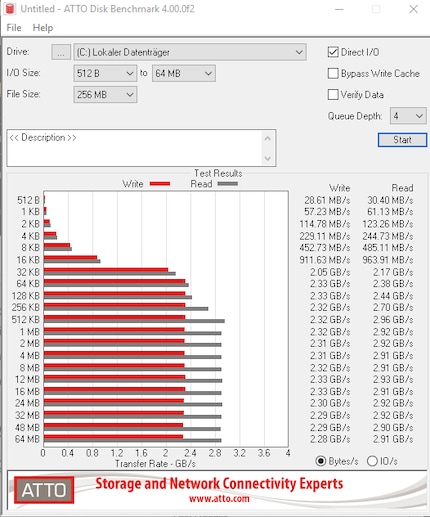
Unfortunately, I do not have a Samsung EVO 970 Plus for the test. Allround-PC.com did the ATTO Disk Benchmark with the 970 Plus and measured 3.4 GB/s. The successor to my 970 beats the SN750.
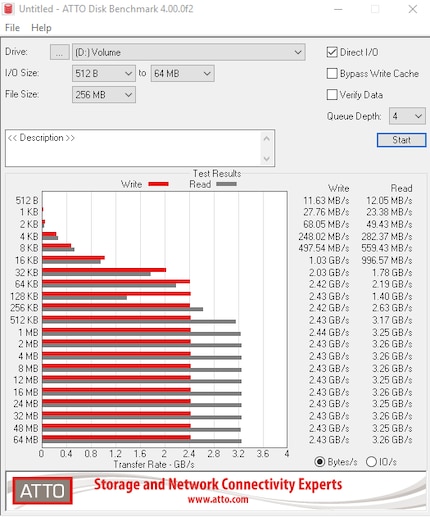
Before I get to the next benchmark, a few words about the heat development. The heatsink actually made a difference during the benchmarks - at least for the temperature. The SN 750 with heatsink never got warmer than 32 degrees in idle mode. The version without the heatsink was on average eight degrees warmer. The Samsung ranks in the middle at 36 degrees. During the benchmarks, the EVO 970 reached up to 44 degrees, the SN750 without heatsink 45 degrees. The version with heatsink didn't break a sweat during the benchmarks and only got up to 36 degrees.
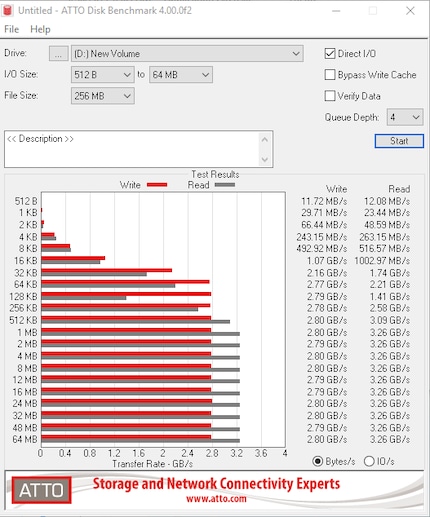
However, these few degrees have no influence on the performance, as the exactly identical results of the SN750 with and without heatsink show.
PCMark 8
The three SSDs are only separated by three points in the benchmark. The EVO 970 and the SN750 with heatsink both achieved a score of 5022. The version without heatsink has 5019 points. If you look at the duration of the individual tasks in the results, the differences are negligible.

PCMark 8 gives a better picture of the actual performance, as it is not a synthetic benchmark. Only milliseconds separate the three SSDs in the tasks. What looks like a big difference in the ATTO Disk Benchmark is not that big in reality.

The poorer performance of the SN750 without heatsink can possibly be explained by the heat development. The storage benchmark took just over an hour in each case. It is possible that the higher temperature of the SN750 without a heatsink had an effect on performance during this time - even if the difference is negligible. However, it is also possible that I would achieve a better result with the SN750 without the heatsink if I ran the benchmark again.

Anvil Storage Utilities
The Anvil Storage Utilities benchmark shows a similar picture to the other two benchmarks. The WD SN750 with heatsink performs best, followed by the version without heatsink. The Samsung EVO 970 follows in third place. The benchmark also shows that the manufacturers effectively favour the test methodology with raw data in their specifications. As soon as compressible and non-compressible data are combined, the SSDs no longer achieve the specified read and write rates.
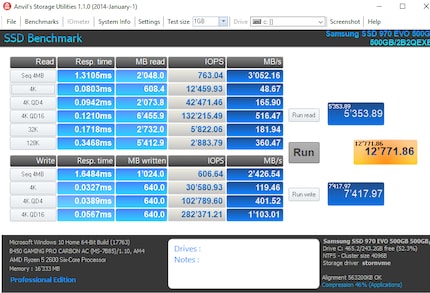
The differences between the three M.2 SSDs are also minimal in this benchmark. Surprisingly, the SN750 with heatsink performed better in every benchmark than the one without heatsink. The version with heatsink has 500 GB of memory, the version without heatsink 1 TB. Theoretically, larger SSDs are faster than smaller ones. This is because the controllers on larger SSDs can address more flash modules at the same time. So why does the smaller SSD perform better in the benchmarks than the larger one?
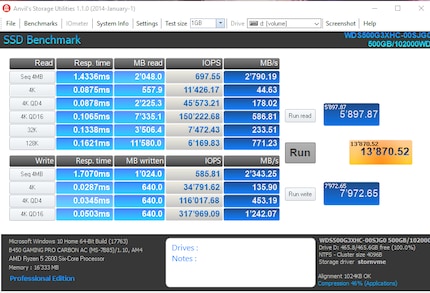
The only explanation I can find for this is that the higher temperature has an impact on performance. On closer inspection, however, this doesn't seem plausible. Most SSDs should be able to develop their full performance at temperatures between 0 and 70 degrees. With a maximum of 45 degrees during the benchmarks, the SN750 without heatsink is far from this. These must therefore be the usual differences in benchmarks. The result is not always exactly the same as with the ATTO benchmark.
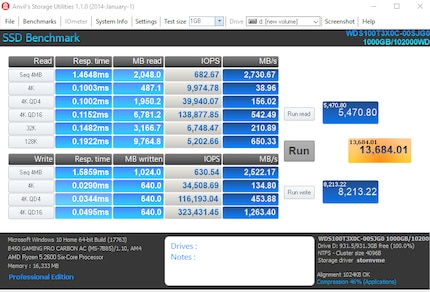
Real-world tests
After all these benchmarks, I want to know how well the SSDs perform in real-world applications. To do this, I first measure the loading times in the games "Final Fantasy XV", "Rise of the Tomb Raider" and "Resident Evil 2 Remake".
In "Rise of the Tomb Raider" and "Resident Evil 2 Remake", the Samsung EVO 970 beats the competition. In "Resident Evil 2 Remake" only by milliseconds, in "Rise of the Tomb Raider" by several seconds. The two WD Black models are more or less on a par. In "Final Fantasy XV", the game with the longest loading time, the SN750 without heatsink wins the race. It is over a second faster than the Samsung EVO 970, closely followed by the SN750 without heatsink.
In the video you can see the loading times in the head-to-head race.
As a final test, I install "Battlefield 5" from the drive, onto the drive and measure the time. Here the SN750 with heatsink is ahead in 5:35 minutes. The SN750 without heatsink is in second place with just under four seconds. In third place is the Samsung 970 EVO with 5:50.
The SN750 without heatsink gets 60 degrees during the copying of the installation data. This temperature also remains during the installation of "Battlefield 5". However, this only has a minimal effect on performance. With an installation time of over 5 minutes, I consider four seconds to be negligible. And an installation doesn't always take the same amount of time. As with the benchmarks, it will always take a different amount of time.
Conclusion
The WD Black SN750 is fast and can also keep up with the competition from Samsung. But does the heatsink really help? It certainly makes sense from a temperature perspective. The variant with heat sink reached a maximum of 36 degrees, the one without heat sink up to 60 degrees. So the difference is enormous. However, this difference had no effect on performance. As a gamer or average consumer, you can confidently go for the version without the heatsink and invest the money in larger memory. The variant with heatsink makes sense in a server as a cache.
I have to point out one more fact about heat development: Since the test system is water-cooled, little air circulates around the M.2 SSD. With an air CPU cooler, there would be a constant breeze around the M.2. It is quite possible that the SSD would be less warm with an air-cooled system. However, the opposite may just as well be the case, depending on the heat of the CPU exhaust air.
From big data to big brother, Cyborgs to Sci-Fi. All aspects of technology and society fascinate me.






